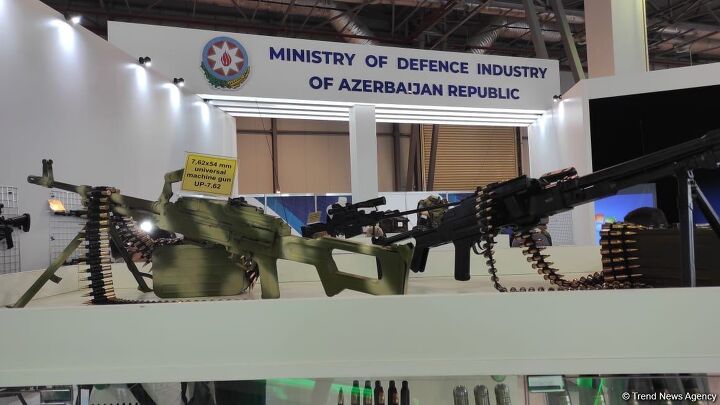Azerbaijan PKM Production

This series of articles primarily focuses on the post-Soviet states in the South Caucasus region, which have inherited large stockpiles of arms from the collapse of the Soviet Union in 1991. However, these stockpiles are finite and are rapidly depleted during conflicts. This issue is particularly evident in the long-standing tensions between Azerbaijan and Armenia over regional territorial disputes, which trace back to the aftermath of World War I.
These disputes led to the Armenian-Azerbaijani War from 1918 to 1920, which began in the final months of World War I and concluded with the Soviet invasion and takeover of the region. Over the subsequent seventy years, both countries relied heavily on the Soviet defense industry. In the late days of the Soviet Union in 1988, fighting reignited with the First Nagorno-Karabakh War, which ended in a ceasefire agreement in 1994.
Azerbaijan took 14 years to develop its defense manufacturing industry. In 2005, the government issued a presidential decree to establish the Ministry of Defense Industry of Azerbaijan. This state-owned enterprise was created to produce arms for defense and later to facilitate exports, thereby increasing revenue from military sales.
The establishment of this industry contributed to the production of arms and the modernization of weapon systems, helping Azerbaijan build a more independent and militarily capable nation while enhancing regional security.
Addressing the need to replace Soviet-era weapons is crucial, as all equipment has a service life and eventually expires. This has led to the reproduction of Soviet-based designs, and it is hard to beat the AK and PKM in reliability and durability. For example, in 2011, Azerbaijan began manufacturing 5.45mm AK-74M assault rifles under a license from Russia called the Khazri. Along with these rifles, they also produced a 5.56mm AK-101 clone, known as the EM-14, and a 7.62x39mm AK-103 clone, called the AZ-7.62.
Rosoboronexport signed the AK-74M Khazri license contract with Azerbaijan in 2010. This contract spans ten years, and based on the annual output, the total production volume could reach up to 120,000 rifles, which are intended solely for domestic use. The contract can also be renewed upon its expiration.

The Azerbaijan PKM Production
I’ve extensively covered the PKM machine gun throughout my journalistic career and I will continue to cover anything related to this machine gun. The PKM was initially designed in the Soviet Union and has been produced globally by various manufacturers under different licenses. In Azerbaijan, the Ministry of Defense Industry manufactures the PKM machine gun. Both modernize existing weapons and make new models to satisfy domestic needs and export demands.

Starting with the UP 7.62 (7.62x54mm) Universal Machine Gun, we have the basic PKM general-purpose machine gun and the HP 7.62 (7.62x54mm) Offensive or Assault Machine Gun. The HP 7.62 is a modernized version of the PKM, designed as a lighter-weight assault machine gun at 15.4 lbs. (7 kg), while the UP 7.62 is a standard PKM weight of 16.5 lbs. (7.5 kg). It features a shorter fluted barrel and a Picatinny rail on the feed tray cover for optics attachment. Unlike most models in the PK series, the HP 7.62 includes a handguard specifically designed to accommodate additional Picatinny rails for accessories. The barrel is equipped with a heat shield, and the 100 and 200-round ammunition can have a unique 45-degree angle on the left side to provide space for the shooter’s right arm. A retractable stock features a cheek riser to accommodate different optic heights. Notably, the bipod on the HP 7.62 is removable, allowing for various configurations.

The HP 7.62 was developed in 2012, and in 2018, mass production for the Armed Forces of the Republic of Azerbaijan, primarily border guards, particularly units of its special forces and reconnaissance units.
The advertised system lifespan for the HP 7.62 and the UP 7.62 is 25,000 rounds, which sounds low, but hopefully, they are referring to the barrel service life. The rear sight on the HP 7.62 graduated to 1,000 meters, whereas the UP 7.62 had a standard of 1,500 meters. Both models have a rate of fire between 650 and 750 rounds per minute. I have no hands-on experience with the Azeri take on the PKM, but I hope to in the future and will provide a follow-up on it.

UP 7.62 (7.62x54mm) Universal Machine Gun Specs:
- Rate of fire RPM: 650
- Practical rate, RPM: 250
- Muzzle velocity, m/s: 825
- Maximum effective firing range, m: 3800
- Sighting range, m: 1500
- Ammunition box capacity, rounds: 100, 200
- Barrel length, mm: 605 (24 inches)
- Sight radius, mm: 663
- Overall length, mm: 1160
- Weight without ammunition box, kg: 7.5
- Weight of loaded ammunition box: – with loaded 100-round metal belt, kg: 3.9 – with loaded 200 round metal belt, kg: 6.5
- System life, rounds: 25,000
HP 7.62 (7.62x54mm) Offensive Machine Gun Specs:
- Ammunition: 7.62×54 mm
- Rate of fire: 650 RPM
- Practical rate: 250 RPM
- Muzzle velocity: – 820 m/s
- Effective firing range: 1000m
- Ammunition box capacity: 100, 200 rounds
- Barrel length: 517mm (20 inches)
- Overall length: Buttstock folded at 980mm / Buttstock open at 1080 mm
- Weight without ammunition box: 7 kg
- System life: 25000 rounds



